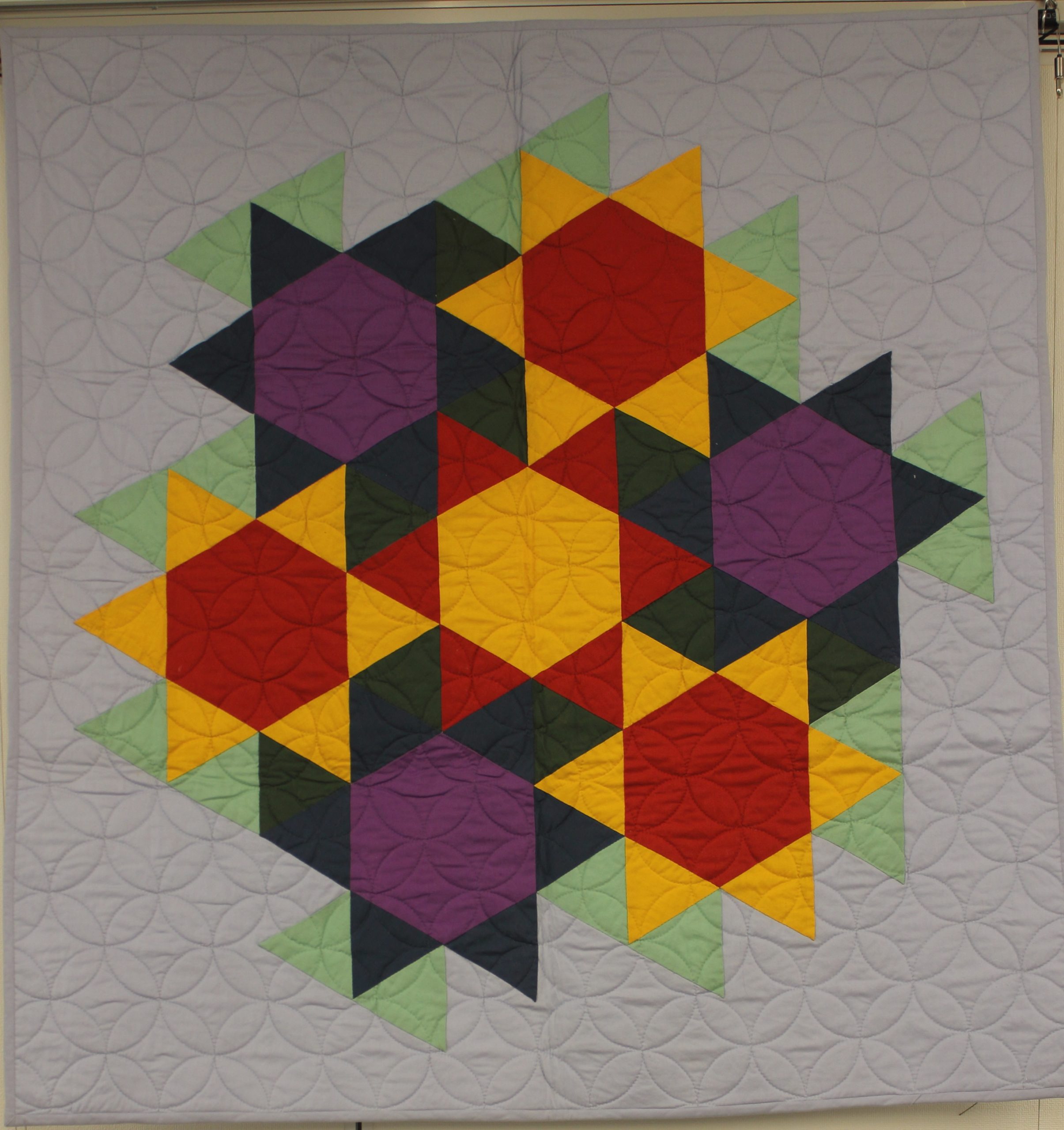- About Lotus Series
- Honeycomb and six leaf clover
- Cross flower and four leaf clover
- Jagged Yarrow grass swaying in the wind
- Jagged flower floating in the wind
- Midsummer’s Hexagram flowers
- Water chest nuts flower
- When the water chest nuts flowers bloom
- Dodecagonal melancholy
- Bouquet of Primrose
- Sparkle on the surface of the water
About Lotus Series
It was based on the image of flowers floating on the water, and at that time, it was a series that I hoped would be able to be aware of the environment and ecology. Now the effects of climate change have appeared prominently and have become a subject to emphasize even more. As a work, it is the one that geometric fun is pursued by using the square, etc., and quilting can be expressed clearly by using a simple shape, a limited number of colors, and a plain cloth.
At the time, I asked the quilt forum of Japan’s largest personal computer communications, Nifty Serve. Therefore, the following quilter name is the handle name in the forum. In addition, quilting is one that each creator has decided, I am grateful that they have made a good match to the configuration and color scheme. Perhaps, it is thought that they faced for a long time in the process of making the quilt top, and they ware able to reach a deep understanding of the geometric meaning.
In addition, the Lotus series is divided into phase I and II depending on the time period. The fabric’s color is slightly different even in the same color, because the Japanese economic bubble burst, the kinds of cloth was halved, and there was no cloth with the same color number.
Honeycomb and six leaf clover
Made by Kirin-san at 2001
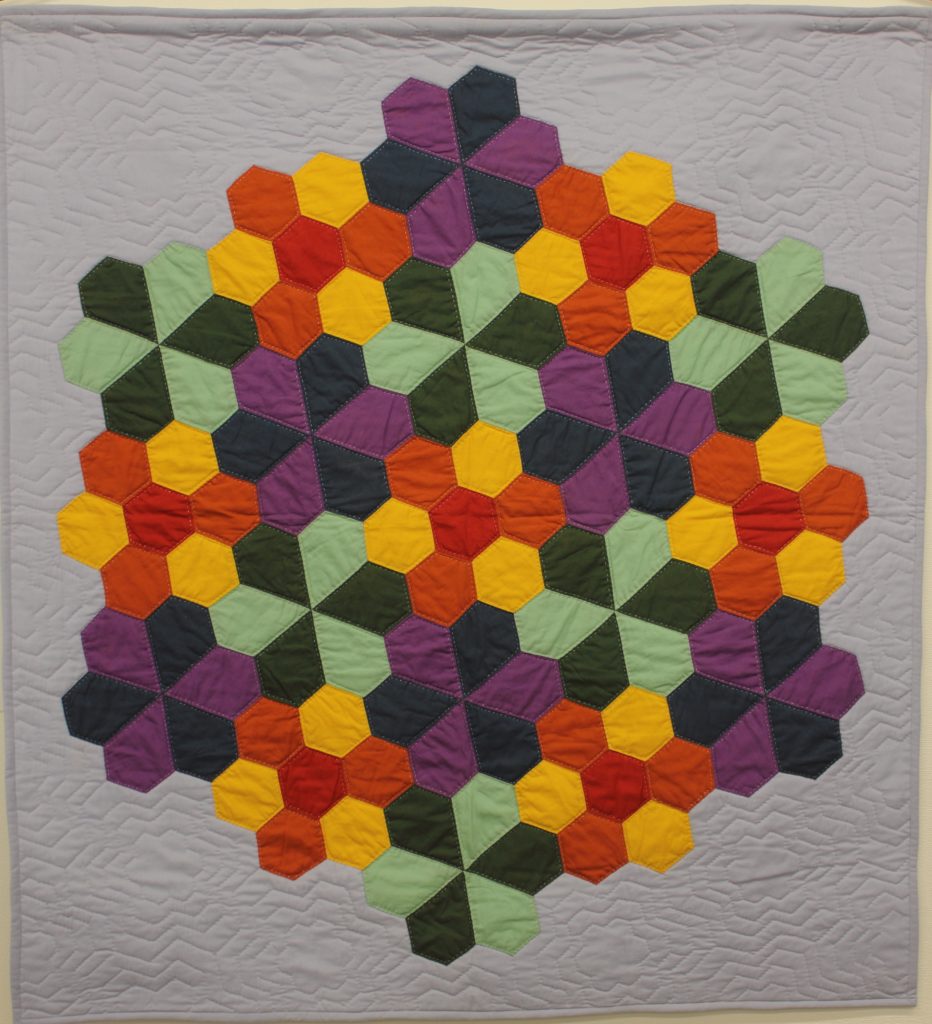
Commentary: A design that uses an array of pentagons that combine a regular hexagon and a regular triangle.
The flower is represented by combining seven regular hexagons as shown below, but the shape which divides the shape into six equals becomes a pentagon. Because the outline is the same, it can be arranged well, and it is an array which uses it. If you know that, you’ll find this array interesting. In addition, you can enjoy that the made pentagon is reminiscent of a diamond on the ring, and it becomes a clover of six leaves when it looks like a leaf.
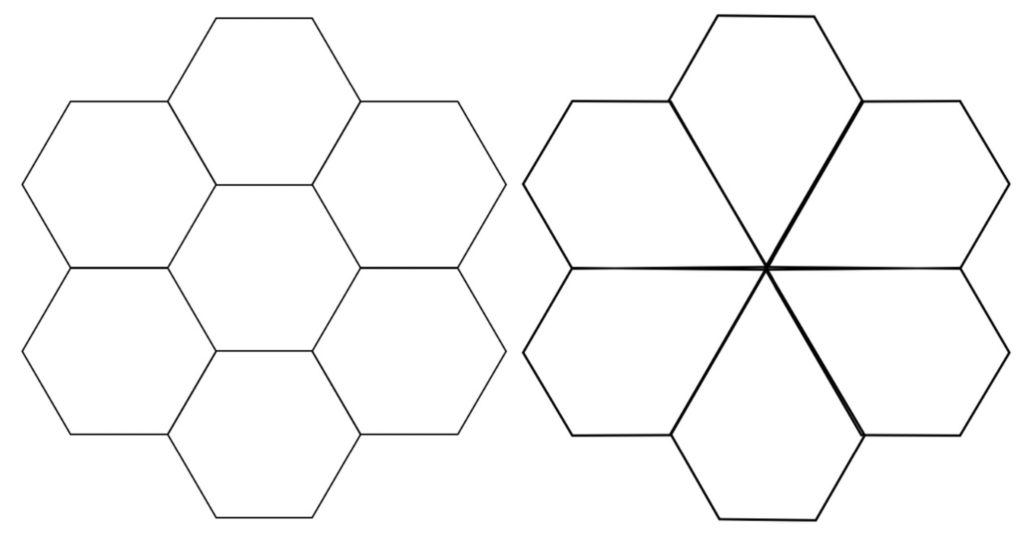
Supplemental figure: 6 pentagons with the same outline as seven regular hexagons
Cross flower and four leaf clover
Made by Mii-san at 2001
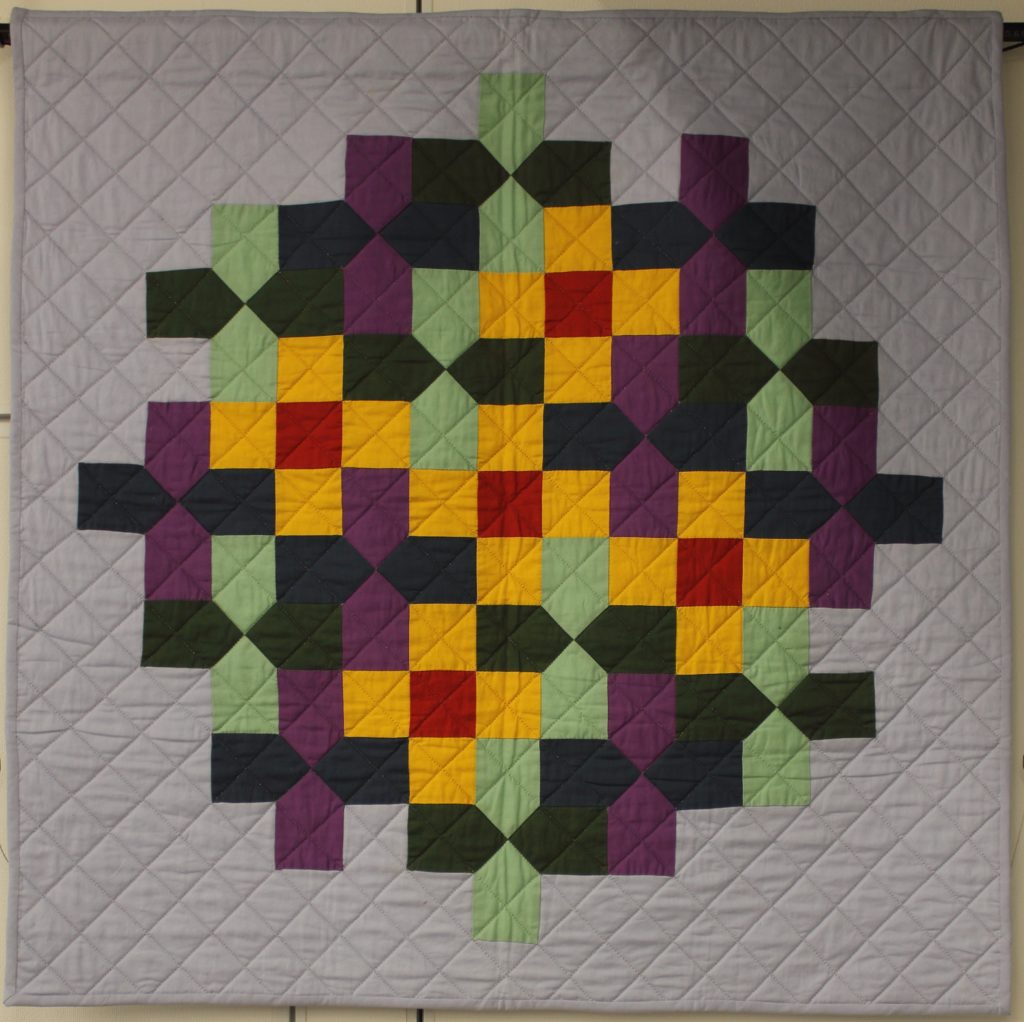
Commentary: Designed using an array of pentagons that combine square and right-angle bisector triangles.
The flower is represented by combining five squares as shown below, but the shape which divides to four equally becomes a pentagon. Because the outline is the same, it can be arranged well, and it is an array which uses it.
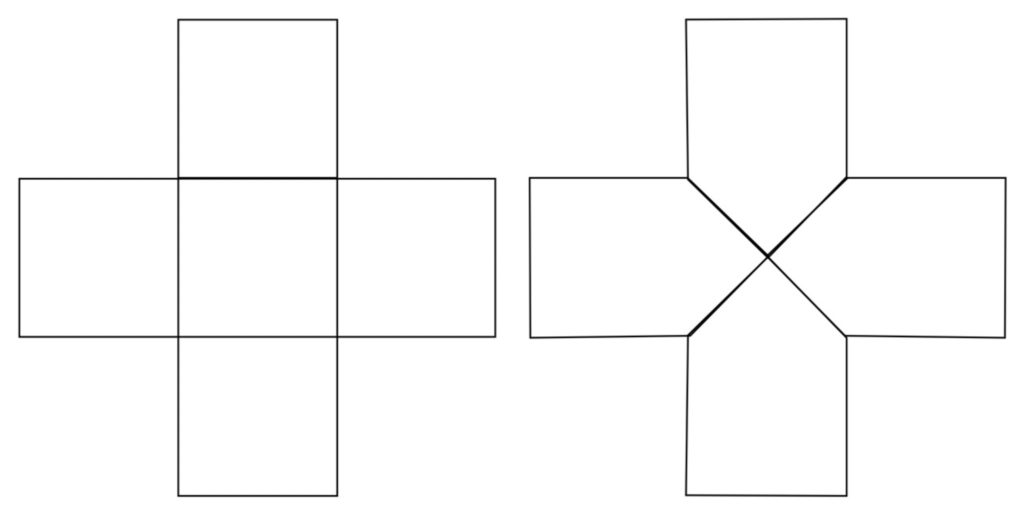
Supplemental figure: Four pentagons with the same outline as five squares
Jagged Yarrow grass swaying in the wind
Made by Gucky-san at 2001
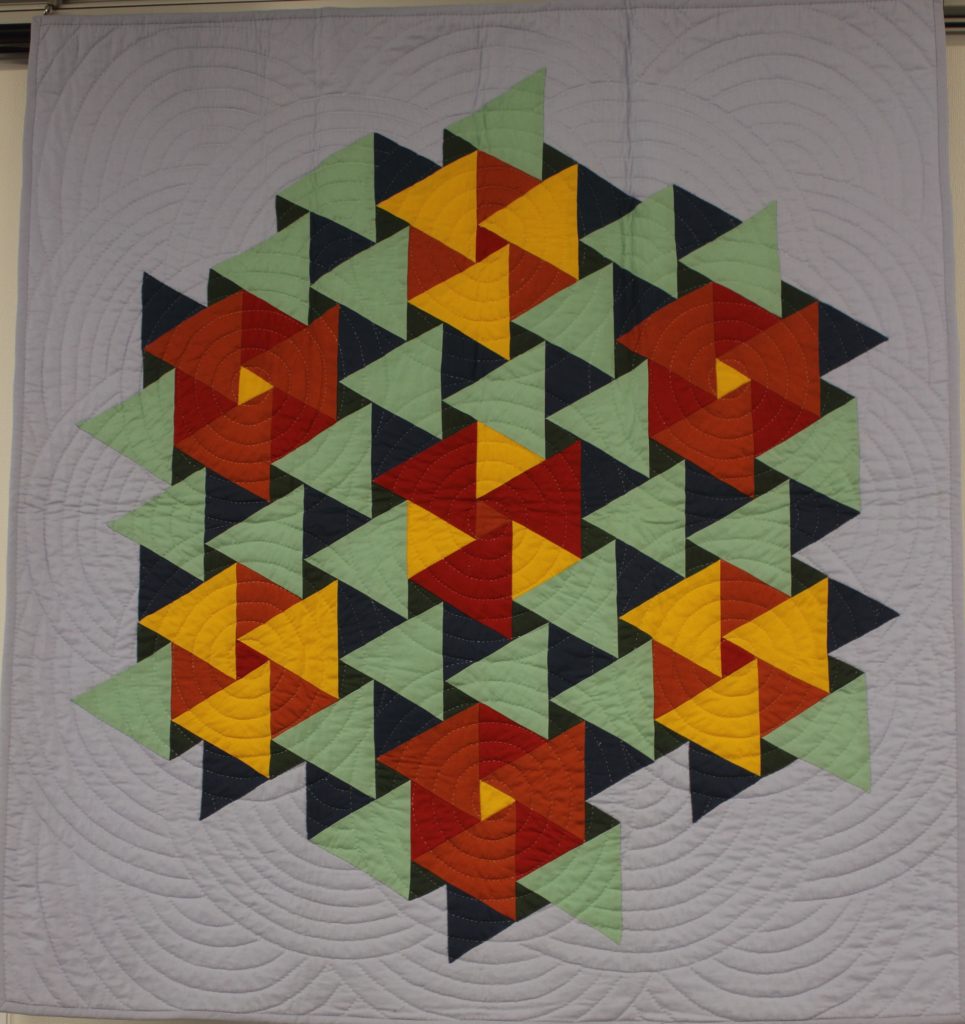
Commentary: Designed using three kinds of regular triangles of different sizes.
If you want to tiling using regular triangle of three different sizes, you can create a good array if you make the total length of two small sides to the length of the large triangle equally. In the case of this design, it is a ratio of 1+2=3. It will be interesting to design at the ratio that you think is beautiful.
As for the color scheme, the part of the leaf showed how the new leaf grew greatly thanks to the old leaf in two colors of moe yellow and deep green. The flower part used three colors of red-orange yellow, and showed regularity and diversity at the same time.
Jagged flower floating in the wind
Made by Suzuyu-san at 2001
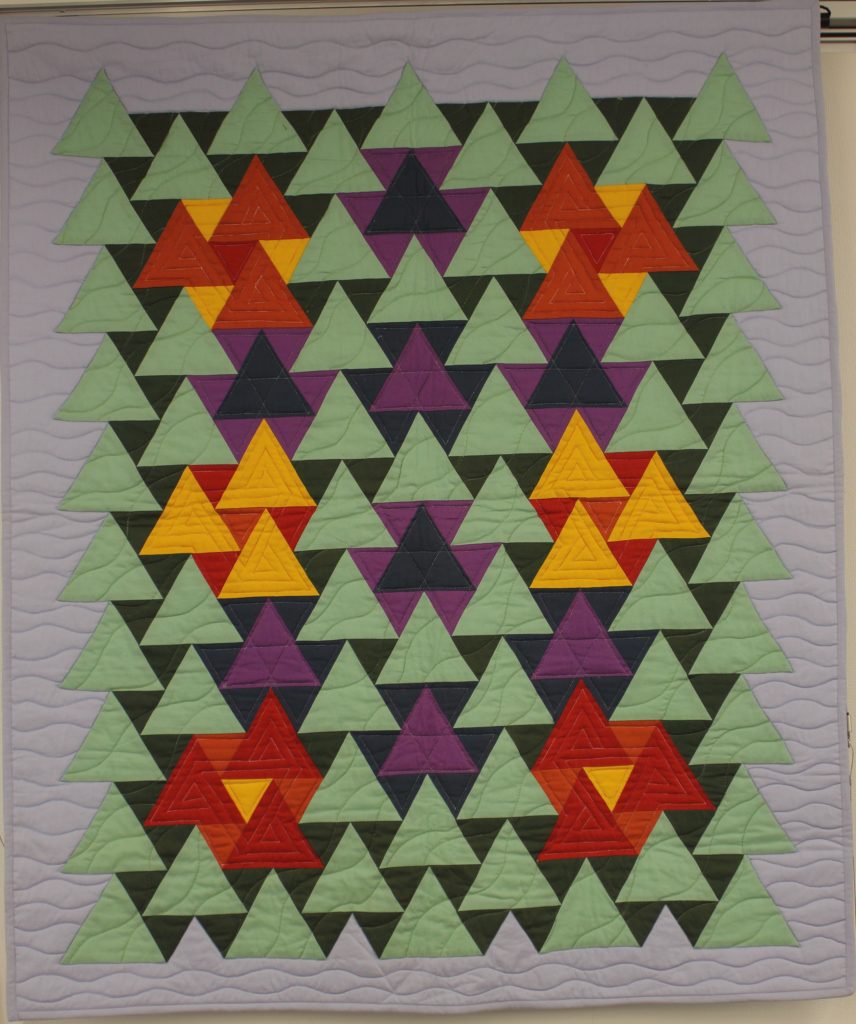
Commentary: Designed using two kinds of regular triangles of different sizes.
Because two kinds of regular triangles of different sizes were used without using regular hexagons, the corner angle stood out and it was made a water grass named jagged grass.The flower was surrounded by each three regular triangles, small and large, and formed into a uniform shape.
Midsummer’s Hexagram flowers
Made by Redomi-san at 2001

Commentary: Designed with regular triangles and regular hexagons.
About 40% of the flowers are five petals. There are various theories as to why there are so many five petals flowers, and one of them is that the shape is three-dimensional. In fact, regular triangles, squares, and regular pentagons can form regular polyhedrons by themselves, but regular hexagons cannot. Hexagon must be supported by regular pentagons like soccer balls.
On the other hand, a regular hexagon is overwhelming in a two-dimensional plane and not only can the plane be constructed by itself, but it can also be used in combination with various polygons. I think this design is the simplest and most powerful of all combinations of regular triangles and regular hexagons, and I made use of it to create a powerful design.
Water chest nuts flower
Made by Kimiyo-san at 2001
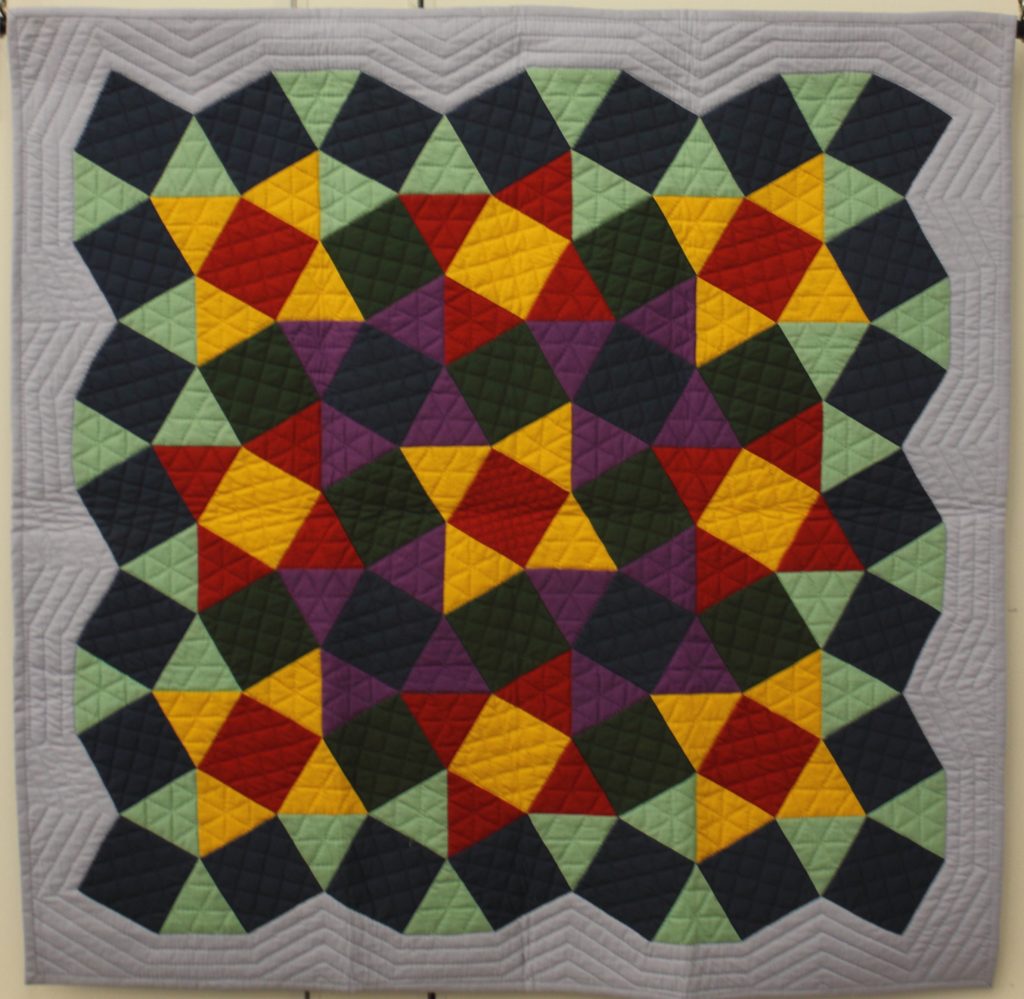
Commentary: Design using a regular array of regular triangles and squares.
Regular triangles and squares can form a periodic array. The ratio of regular triangles and squares is 2: 1 and the squares and, rhombus created by two equilateral triangles are arranged in an alternating order.
I personally think it is the simplest and most beautiful array.
By the way, Hime water chest nuts is not only a four petals flower, but also has a quadrilateral nuts, which grows at the end of summer.
When the water chest nuts flowers bloom
Made at 2001
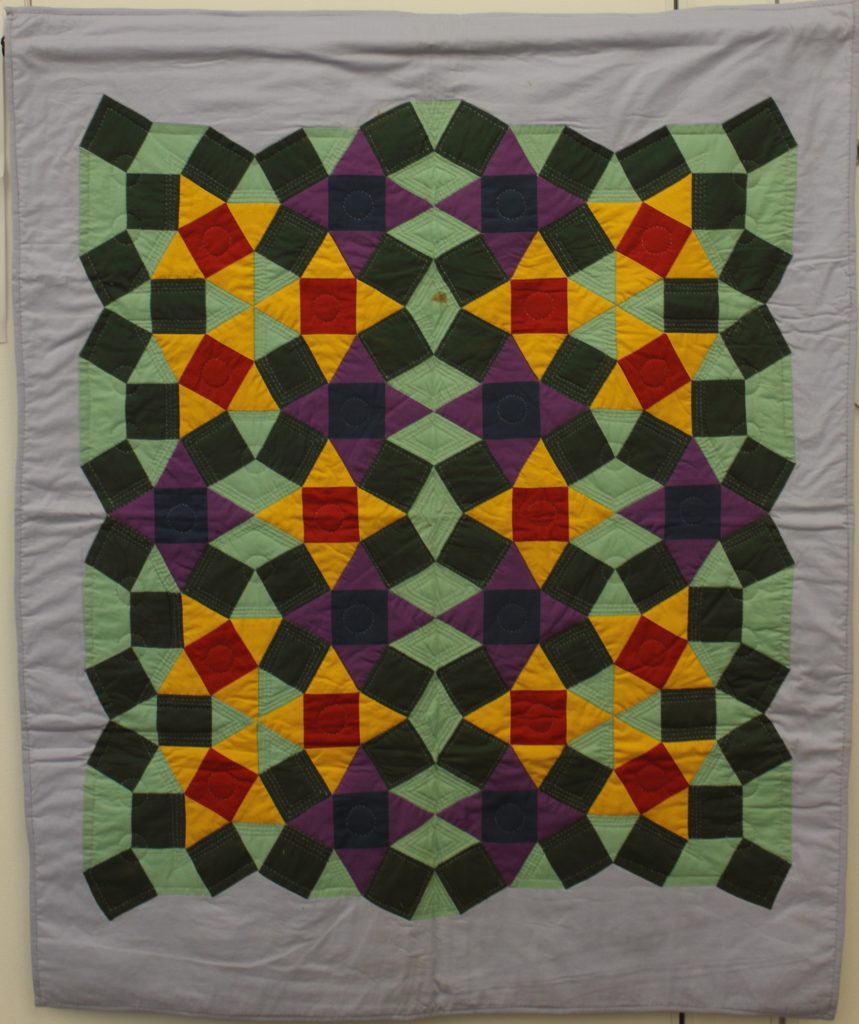
Commentary: Designed using the internal division of regular dodecagon.
The three regular dodecagons can be arranged as shown in the left figure below, and the gap becomes an equilateral triangle. A regular dodecagon can be internally divided into regular triangles and squares as shown in the figure on the right. The work was designed by dividing it into the regular dodecagonal arrangement inside and using the regular triangle and square arrangement.

Supplementary figure: regular dodecagonal array and internal division. Photograph of water chest nuts flower
By the way, the photograph below is water chest nuts flower, and a rare four petals flower. In the hot season of early August, the water chest nuts flowers bloom, and when you find a clean and modest flower of about 1cm, I feel that the heat is healed a little.
Dodecagonal melancholy
Made by Moto-san at 2001
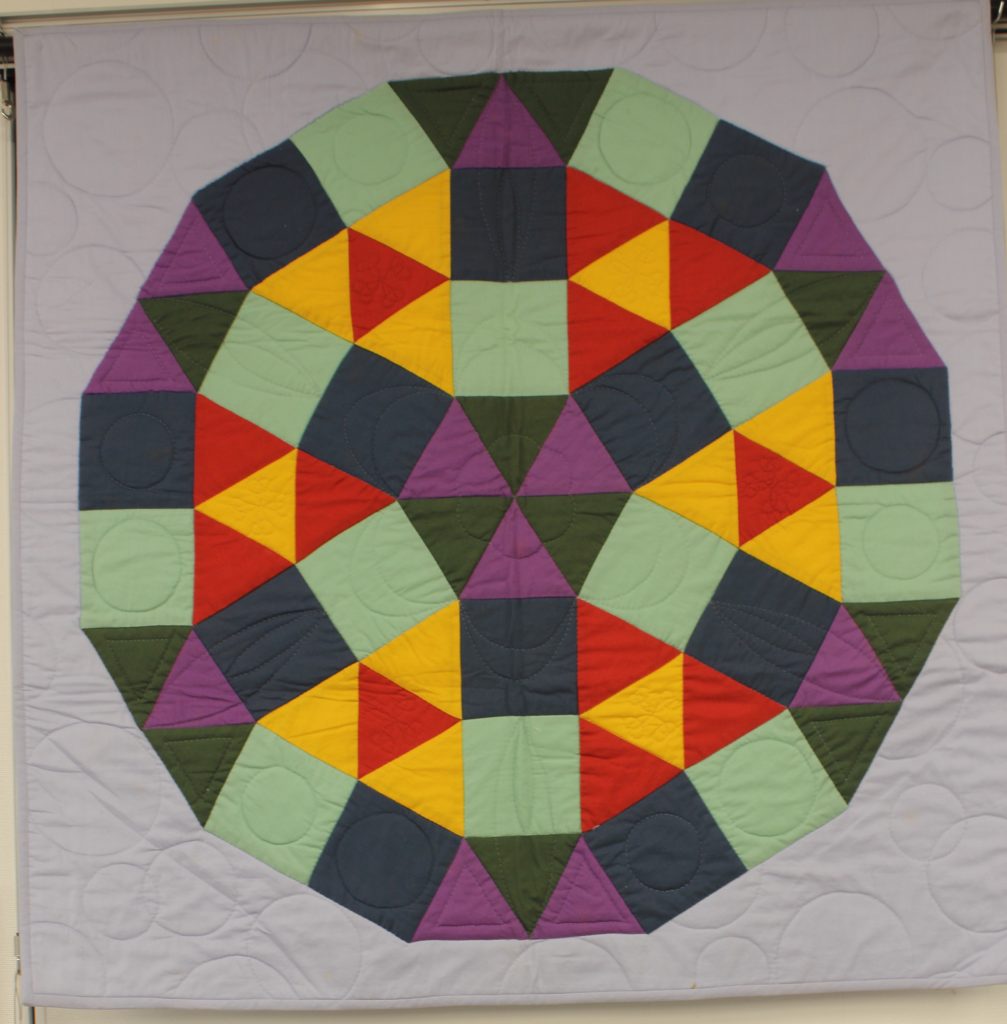
Commentary: Designed with a double hierarchy of Dodecagon
It is known that a regular dodecagon can be divided into squares and regular triangles as shown in the left figure below, but in fact, it has a double-layered structure as shown in the center figure and a triple-layered structure as shown in the right figure, and more.
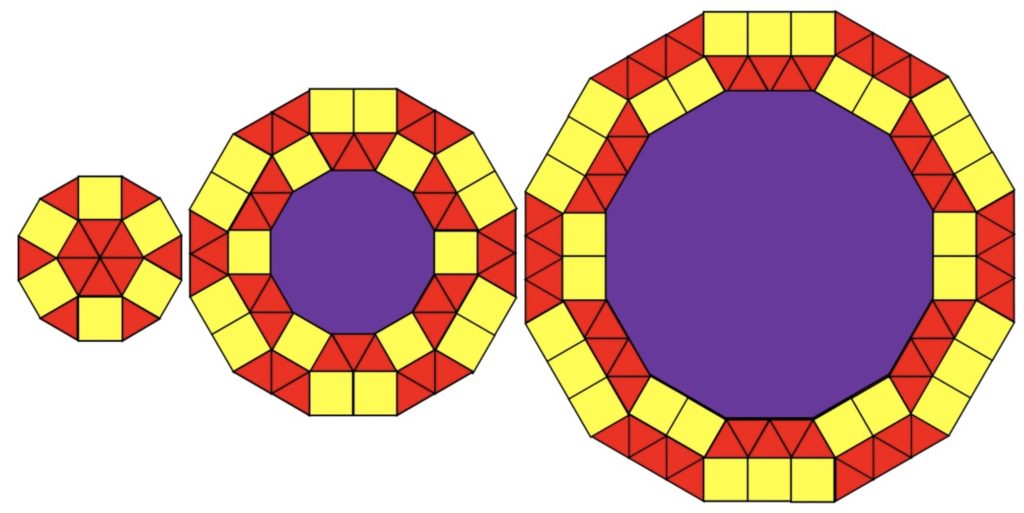
Supplemental figure: Hierarchical structure of dodecagon
In the supplemental figure, it is drawn so as to be able to put the left portion respectively to the purple portion.
In addition, this design was designed using a double hierarchy that was not too complicated and made you imagine the rest.
Bouquet of Primrose
Made by Yuua-san at 2001
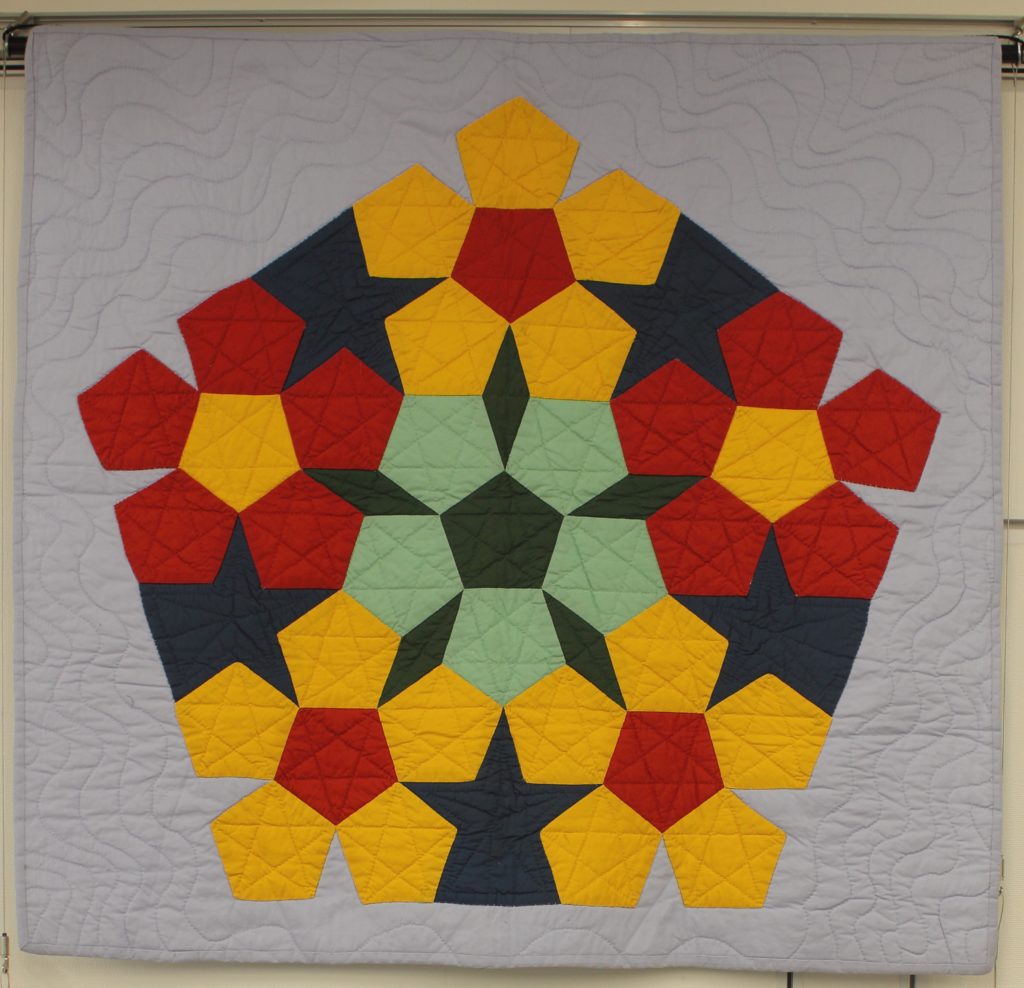
Commentary: Designed with a double array of orthodox pentagons

Supplemental figure: Multiple array of regular pentagons
By arranging 6 regular pentagons, you can make a regular pentagon with a red frame as shown in the left figure above. When the regular pentagons are arranged in the same arrangement, the arrangement shown in the central figure is obtained, which is also a regular pentagon with a red frame with a gap. If the regular pentagons with this gap are arranged in the same arrangement, the arrangement shown in the right figure is obtained.
It can be repeated, but it was designed with a double array that is not too complicated and makes you imagine the rest.
The regular pentagonal quilting is made of pentagram, and it reminds us of smaller arrangement.
Sparkle on the surface of the water
Made by Chap-san at 2001
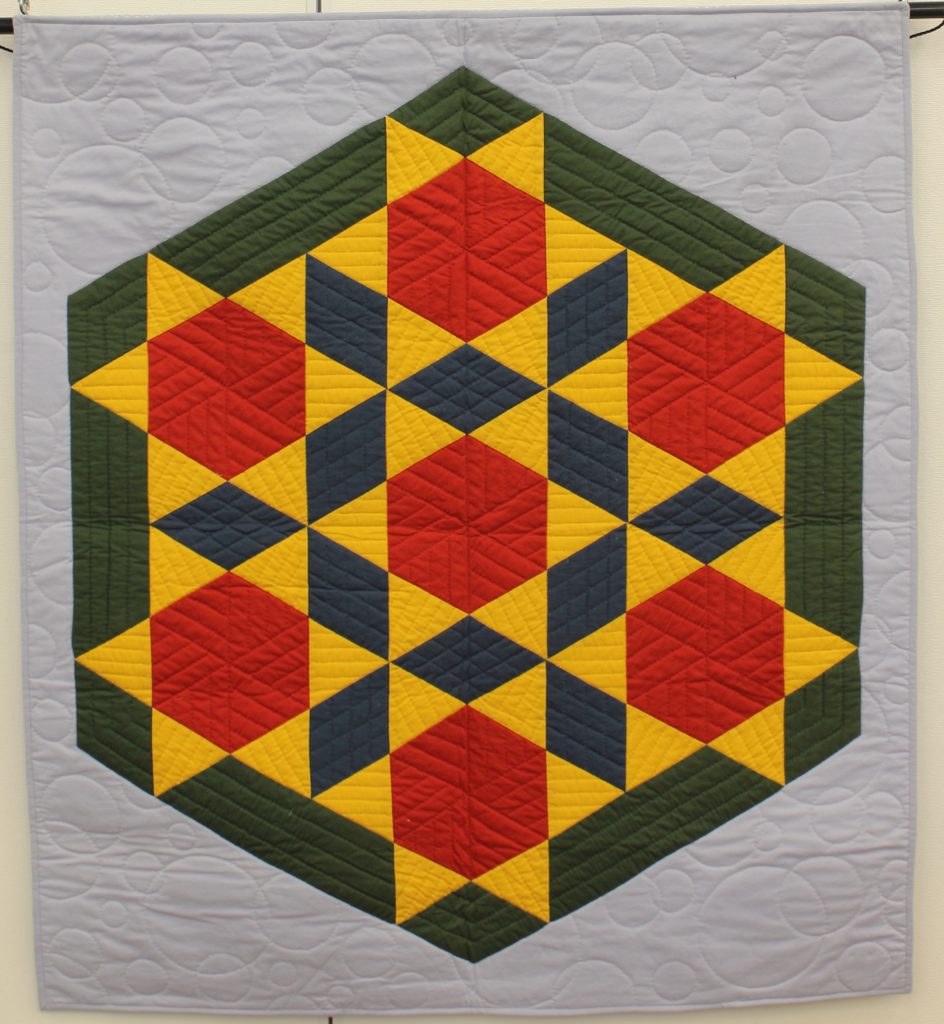
Commentary: Unfortunately, it is not possible to form a large regular hexagon using only a regular hexagon of the same size. While not being able, I tried to make the design to impress the regular hexagon and the hexagram in and out strongly. In addition, it has become an interesting arrangement that appears while replacing the three diamond mark when you look at the inner diamond.
